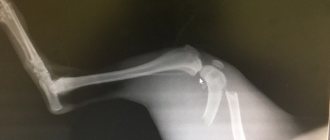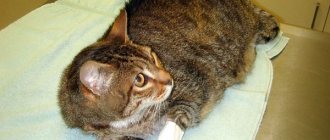Thanks to the unique structure of the hearing aid, cats are able to land deftly on all four paws. However, sometimes troubles happen to them in the form of fractures of the limbs, tail, jaw, and damage to the articular ligaments.
We will learn how to determine that a cat has broken its paw, what to do first, and how to help the animal at home.
What is a fracture
This concept includes 2 points: a violation of the natural state of bone tissue and the presence of a mechanical factor that caused the injury. A bone breaks if the force of an external force exceeds its strength.
Doctors divide all possible fractures into traumatic and pathological injuries. The former are a consequence of mechanical intervention.
In most cases, these are falls, car injuries, or dog bites.
The causes of pathological bone damage are diseases that have a negative effect on bone tissue. Such ailments include osteoporosis, metabolic disorders, oncology, hyperparathyroidism (leaching of calcium from the body due to poor nutrition).
Conservative method
This method includes a treatment algorithm:
- realignment of bones;
- immobilization;
- creating the most calm conditions for rehabilitation.
You should not run this because after 2 days it will be even more difficult to put the bone in place. For such procedures, it will be necessary to relax the animal’s muscles and administer local anesthesia so as not to aggravate the condition. If you see a doctor later, you will have to break the bone again.
Causes
If a cat lives in the house, you need to take into account the characteristics of its character. Some of them pose a potential threat to the health of the animal. The animals are extremely curious, and they also have a very strong hunting instinct.
A cat can forget about everything in the world if it is chasing a bird or a fly. If she is sitting on the edge of the windowsill at this time, the matter may end in injury.
The most common causes of paw fractures in cats are:
- jumping from heights;
- injuries on the highway;
- accidental injuries (for example, being caught in a door);
- development of osteoporosis, rickets or osteomalacia;
- blows that were inflicted by people or animals;
- congenital fragility of the musculoskeletal system - as a rule, this feature is found in purebred animals;
- exposure to external factors that weaken the immune system and reduce bone density;
- osteosarcoma;
- infectious lesions.
According to statistics, paw fractures are most common among felines. The pelvis, tail or spine are much less likely to be injured.
Reviews of doctors providing the service - Application of a circular plastic bandage
Several months ago, Igor Grigorievich performed arthroscopic surgery on my acromioclavicular ligament.
Installed dogbone implant. Everything is great, I lead an active lifestyle and play sports. I already forgot which side it was from! Read full review Alexey
25.11.2019
Dear employees, dear management of the Endosurgery and Lithotripsy Center, good afternoon! 2 months ago I had hip replacement surgery performed by specialists from the Center: Vladimir Sergeevich Zubikov - orthopedic traumatologist, doctor of medical sciences, doctor of the highest category, ... Read full review
Pershin Vladimir Alekseevich
20.08.2018
Classification
The concept of “fracture” has a clear definition, but depending on the causes or consequences, several types of fractures are distinguished.
By time of manifestation
All types of limb injuries in cats are conventionally divided into 2 types: congenital and acquired. In turn, each of these broad groups is divided into several types, which unite injuries according to a common characteristic.
In the case of a congenital fracture, the cat already has bone damage at the time of birth. A fracture of the paw in such a kitten occurs even at the stage of intrauterine formation.
The reasons may be:
- Anomaly of physical development of the fetus.
- Cat bruise during pregnancy.
- Systemic failure in the formation of bone tissue. This anomaly persists in the animal for life; its bones will break even from minor loads.
Damage that occurred after birth is classified as acquired. For most adult cats, their cause is insatiable curiosity. The second most common injury rate is road traffic accidents.
Interesting! It happens that broken paws in kittens occur due to an error during delivery. If the animal breaks its leg under such circumstances, it is too late to decide what to do; you need to urgently call a veterinarian.
According to the nature of the damage
Fractures in cats can be open or closed. In the first case, bones are visible through the injured tissue. The animal may behave inappropriately and experience severe shock.
Such fractures are considered the most dangerous, because the risk of infection is very high. In addition, there are often cases when it is difficult to stop the bleeding - so the cat runs the risk of dying from blood loss.
Closed fractures may not be noticed at first. But the cat’s behavior, his inability to step on the injured limb, cannot fail to attract the owner’s attention.
This type of injury has a high probability of recovery after surgery.
In the direction of the damage line
There are several types of bone fractures, which are classified depending on the direction of tissue destruction. The reasons for the differences in the clinical picture in one case or another lie in the variety of factors that provoked the injury. They determine the nature and direction of the pathological effect.
Table 1. Types of fractures according to the direction of damage
| Name of fracture | Nature of injury |
| Transverse | Perpendicular impact, bone split in half. |
| Oblique | The bone fracture line runs at an angle. |
| Longitudinal | The bone is broken in the longitudinal direction. |
| Spiral | Fracture due to twisting movement of the limb. |
| Splintered | Large bone fragments are observed in the area of injury. |
| Fragmented | The bone was crushed into pieces as a result of multiple fractures. |
For your information! Any fracture in a cat has its own localization. If the flat bone is injured, the pelvic area will be treated. If a cat has a broken front or back leg, it means the tubular bones are damaged. The “other” category includes fractures of the tail, spine, ribs, skull, and jaw.
When is surgery needed?
Surgery is necessary if the bone is very visible. The operation is performed using:
- pins;
- staples
The operation must be performed within 2 days after the injury to avoid breaking again. If the bone heals incorrectly, further problematic gait with painful manifestations is possible.
If you follow all the points prescribed by the veterinarian after the operation, you can achieve an excellent recovery and a quiet recovery period.
cat care
Symptoms
The most important sign of a broken paw in a cat is the animal’s inability to step on the injured limb. The animal moves with uncertain jumps on 3 legs. If the hip bone is damaged, the animal cannot rise at all and lies on its side.
Signs of a closed fracture are:
- lameness;
- unnatural mobility of bones when palpating the damaged area;
- the pitiful meow of a cat;
- sounds that resemble crunching;
- swelling of the sore spot 4–5 hours after the injury or a day later (depending on the intensity of the damage);
- decreased appetite in the animal.
With a closed fracture without displacement of the bones, the animal’s skin turns blue or red against the background of swelling. If the bones are displaced, the soft tissue in the injury area is partially damaged. This is dangerous and may cause internal bleeding.
The signs of a closed paw fracture in a cat are in many ways similar to the symptoms of a dislocation or bone fracture. In this case, the animal is able to move slowly, but experiences severe pain.
There is often some asymmetry of the damaged limb compared to others. Hematomas appear on the cat's skin.
Signs of an open fracture are:
- Visibility of the wound.
- Abundance of blood.
- Visual fixation of bone fragments that protrude from under the torn skin.
- The animal is in shock due to severe pain.
Important! Only a medical specialist can make an accurate diagnosis of a cat.
How to find out?
- becomes apathetic;
- prefers to lie down more;
- hiding;
- refuses food;
- limps;
- rises heavily to his feet;
- cannot stand up (pelvic fracture).
However, if a cat moves on three legs, this does not mean that it necessarily has a fracture. Perhaps a splinter got into the paw, making it painful to step on, a dislocation occurred, or the cat was injured or hurt.
Before administering first aid, carefully inspect the paw. A fracture is indicated by:
- strong pain;
- unnatural bone mobility;
- anatomically incorrect placement of the limbs (turned in the opposite direction);
- edema, swelling;
- crunch when palpated.
Upon examination, the cat will most likely scream and try to escape. Be kind to your pet. Before examination, calm the animal and place it on your lap. Try not to squeeze the paw too hard, gently probing with two fingers.
What to do if your cat breaks his paw
If a kitten breaks its paw, you first need to determine the presence or absence of bleeding and try to stop the bleeding. You will need a pressure bandage. In most cases, this is the most effective first aid measure.
The most dangerous moment for a cat’s life, especially with an open fracture, is blood loss. To stop it, you can use sterile gauze wipes, a handkerchief, or any piece of fabric.
Sterility in this case is not critical, the main thing is to block bleeding. The bandage should be placed slightly above the source of bleeding, and the paw should be bandaged tightly.
It happens that the injured limb dangles, held only by muscles and ligaments. After stopping the bleeding, you should immobilize it - you can use improvised materials as a splint (a straight stick, veneer, a ruler). If you are not sure that you can cope with this task, it is better not to do anything, but simply take the cat to the clinic.
Attention! You cannot set deformed bones yourself; it is dangerous and very painful. Treatment of a broken paw in a cat, taking into account individual symptoms, is best left to a medical specialist.
In such a situation, it is important to take the animal to the veterinarian as soon as possible. Calling a doctor to your home is wasting precious time. It is possible to fully help a cat when it breaks its paw (even if it is a closed fracture) only in a medical facility.
Rehabilitation period
How long the recovery phase will last depends on the severity of the fracture, the general condition and age of the cat. In young individuals, it usually lasts three weeks, with a maximum of 30 days. In an old cat, the healing process is longer - 35-40 days.
To monitor proper fusion of the bone structure, your pet should be taken to a veterinary surgeon for a monthly check-up.
In order to restore the motor function of the damaged limb, elasticity and muscle tone, manual massage should be performed, the technique of which will be introduced by the veterinarian. Daily massage procedures stimulate blood circulation, healing of periosseous tissues, and accelerate the process of bone fusion.
A cat's diet should be balanced, nutritious and easily digestible. The animal needs foods enriched with phosphorus and calcium. However, we must remember that an excess of these components often leads to the formation of stones in the gall bladder and kidneys.
Vitamin and mineral supplements will also help speed up your pet's recovery, but they can only be given after consultation with a specialist. The veterinarian prescribes vitamins based on the animal’s needs.
Diagnostics
You can know for sure that a cat has a broken paw after examining the animal by a veterinarian. An examination is necessary to identify associated injuries, which usually occur after a fall from a height or strong mechanical impacts.
For example, a fracture of a cat’s hind leg is often diagnosed against the background of severe chest bruises and abdominal trauma.
The veterinarian must order an x-ray of the injured limb in order to assess the extent of damage to the animal’s health and draw up an individual therapy plan. Often, x-rays require preliminary anesthesia with sedatives.
Signs
The first noticeable symptom is pain. Animals often try to hide it, so pay attention to these signs:
- Crying, moaning, howling, growling; especially when touching.
- The animal does not walk or does not use its paws or tail when walking. He may tuck his paw, or simply limp.
- Decreased or complete lack of appetite; with jaw injuries, there may be a refusal of solid food.
- Deterioration in the condition of the coat, the cat does not lick itself.
- Swelling or bruising appears on the injured area of the body.
Sometimes when a fracture occurs, the bone pierces the skin. This type of fracture is called an open fracture. In addition, other associated injuries may occur.
Some pets may simply change their behavior - their appetite will worsen, they will become less playful, and they will stop jumping high.
Treatment
Depending on the type of fracture, the doctor may prescribe a specific type of treatment or prefer a comprehensive approach.
Surgical (osteosynthesis)
For open, multiple, depressed fractures, surgery is indicated. Osteosynthesis is the joining of broken bones with subsequent fixation of their edges.
There are 3 types of osteosynthesis-type operations that are practiced for broken paws in cats:
- Intramedullary fusion. During such osteosynthesis, the bones are connected using a metal rod. In difficult cases, part of it is brought out. This technique is quite effective and is popular all over the world.
- Extramedullary method. A plate is attached over the aligned bones. The method is used exclusively for the treatment of adult animals that do not suffer from brittle bone tissue.
- Extrafocal osteosynthesis. The doctor fixes the patient's paw using metal knitting needles around the perimeter. After such an operation, a long recovery period is required.
If a cat breaks its paw, no doctor can say exactly how long after surgery the damaged bone will heal completely. But as soon as this happens, the internal wires will be removed and a plaster cast will be applied to the limb. How long it will take for a damaged paw to heal depends on the health of the animal and the quality of postoperative care.
Why is a plaster cast ineffective?
Most animals try to remove the plaster cast by chewing it, rubbing it against corners or furniture. This may disrupt the healing process, so try to calm your pet.
A feature of pet fractures is the high level of injury complexity. In furry patients, crack-type injuries are almost never encountered. In most cases, injuries are diagnosed that require reduction and selection of appropriate materials for tight fixation.
According to research, effective fracture healing requires:
- careful alignment of broken bone pieces;
- rigid and long-term fixation of the result;
- active blood supply to the affected area;
- moderate use of the operated limb.
The use of a plaster cast excludes compliance with all these conditions.
Veterinary orthopedic practice confirms that osteosynthesis is the best way to restore the functionality of the limbs after fractures. Plaster casts in such cases are not able to help solve the problem.
Postoperative period and rehabilitation
Carrying out an operation, using needles and medications is a huge stress for the animal. Even in the case of a successful outcome, when all devices have already been removed, the cat will need time for further recovery.
This period is no less important than the previous one. Fractures in cats heal differently, the doctor gives individual instructions to the owners for each furry patient.
Typically, the recommendations are as follows:
- limiting physical activity;
- taking vitamins;
- special feeding regimen, proper food;
- regular checkups.
While your pet is undergoing post-operative rehabilitation, you should call a doctor at home. He will adjust the treatment of a broken paw in a cat, and if symptoms of concomitant diseases appear, treat these diseases as well.
The duration of rehabilitation depends on the condition of the animal and the location of the injury. If a cat has a broken tail, it will be healthy within 30–35 days. For paw fractures, recovery lasts up to 2 months.
Caring for your cat after
The success of conservative and surgical treatment largely depends on proper care of the injured pet. The activity and mobility of a cat negatively affects the healing of injured limbs. That is why the main task of the owner is to limit the freedom of movement of a sick pet.
For this purpose, veterinarians recommend placing the animal in a cage for 14–21 days. The structure should be spacious, but not allow the cat to move around a lot. A bowl of food, food and a tray are placed in the cage.
The rehabilitation period after a fracture depends not only on the type and complexity of the injury, but also on the age of the pet. In young animals, healing occurs in 21–30 days. Limb fractures in an older cat usually heal within 35 to 40 days.
The duration of wearing the splint and the period for removing the staples is determined by the attending surgeon. In case of an open injury, as well as after surgical correction of bone damage, the animal is given a course of antibacterial drugs. A follow-up appointment with the surgeon should be at least once every 3-4 weeks to monitor the correct fusion of bone structures.
Regular manual massage helps quickly restore the motor function of a limb after an injury. The attending physician will show you the technique of the procedure. Massage improves blood supply and trophism of the periosteal tissues, promotes rapid healing and healing of the fracture.
During the rehabilitation period, veterinarians recommend switching a sick cat to easily digestible food that is balanced in nutrients, vitamins and minerals. You should not give multivitamin supplements on your own. A veterinarian should prescribe certain vitamins and minerals.
We recommend reading about dislocation in cats. You will learn about the causes and types of dislocation, symptoms of damage to the tail, hip joint and paw, diagnosis, reduction and indications for surgery. And more about what to do if a cat is lame on its paw.
A broken limb in a domestic cat is not uncommon. Bone tissue texture has many types that influence the choice of treatment method. Conservative methods are used for simple fractures. Complex cases usually require surgical intervention using osteosynthesis. A large part in successful treatment is occupied by competent care and rehabilitation period.










